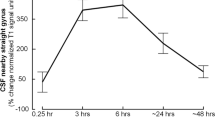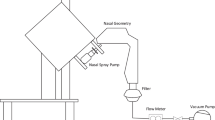Abstract
The nasal administration route emerged as an interesting route in systemic and brain drug delivery, and different modalities of nasal delivery are available. The nasal irrigation is one of them, but there is a lack of studies investigating the distribution of a large-volume irrigation. The main aim of this study was to assess the deposition of radiolabeled saline in the nasal cavities and paranasal sinuses following nasal irrigation by imaging. Five healthy males volunteered to perform large-volume low-pressure nasal irrigation, with a douching device containing 50 mL of radiolabeled isotonic saline. Participants underwent a scintigraphy immediately after. Both the nasal cavities and maxillary sinuses were systematically reached by the solution during nasal irrigation. The sinuses set in a lower position during nasal irrigation showed a tendency to be more irrigated than the sinuses set in a higher position (7.67% vs 22.72%; p = 0.086). Moreover, substantial inter- and intraindividual heterogeneity regarding solution deposition was observed. Large-volume low-pressure nasal irrigation is a good modality to reach the maxillary sinuses as well as the nasal cavities. In order to ensure adequate reaching of both nasal cavities and paranasal sinuses, nasal irrigation should be performed bilaterally.
Graphical Abstract



Similar content being viewed by others
Data availability
The data presented in this study are available from the corresponding author upon request.
References
Bajracharya R, Song JG, Back SY, Han HK. Recent advancements in non-invasive formulations for protein drug delivery. Comput Struct Biotechnol J. 2019;17:1290–308.
el Khafagy S, Morishita M, Kamei N, Eda Y, Ikeno Y, Takayama K. Efficiency of cell-penetrating peptides on the nasal and intestinal absorption of therapeutic peptides and proteins. Int J Pharm. 2009;381:49–55.
Erdo F, Bors LA, Farkas D, Bajza A, Gizurarson S. Evaluation of intranasal delivery route of drug administration for brain targeting. Brain Res Bull. 2018;143:155–70.
Shargorodsky J, Lane AP. What is the best modality to minimize bacterial contamination of nasal saline irrigation bottles?: Disinfecting nasal irrigation bottles. Laryngoscope. 2015;125:1515–6.
Chong LY, Head K, Hopkins C, Philpott C, Glew S, Scadding G, Burton MJ, Schilder AG. Saline irrigation for chronic rhinosinusitis. Cochrane Database Syst Rev. 2016;4:CD011995.
Liu L, Pan M, Li Y, Tan G, Yang Y. Efficacy of nasal irrigation with hypertonic saline on chronic rhinosinusitis: systematic review and meta-analysis. Braz J Otorhinolaryngol. 2020;86:639–46.
Grayson JW, Cavada M, Wong E, Lien B, Duvnjak M, Campbell R, Kalish L, Sacks R, Harvey RJ. Effects of sphenoid surgery on nasal irrigation delivery. Int Forum Allergy Rhinol. 2019;9:971–6.
Grayson JW, Harvey RJ. Topical corticosteroid irrigations in chronic rhinosinusitis. Int Forum Allergy Rhinol. 2019;9:S9–15.
Kim JS, Kwon SH. Mupirocin in the treatment of staphylococcal infections in chronic rhinosinusitis: a meta-analysis. PLoS ONE. 2016;11:e0167369.
Fokkens WJ, Lund VJ, Hopkins C, Hellings PW, Kern R, Reitsma S, Toppila-Salmi S, Bernal M, Mullol J, Alobid I, Anselmo WT, Bachert C, Baroody F, Cohen N, Constantinidis J, Gabory LD, Desrosiers M, Diamant Z, Douglas RG, Hafner A, Harvey RJ, Joos GF, Kalogjera L, Knill A, Kocks JH, Landis BN, Limpens J, Lebeer S, Lourenco O, Matricardi PM, Meco C, Philpott CM, Ryan D, Schlosser R, Smith TL, Teeling T, Tomazic PV, Yun D, Wang D, Zhang L, Agius AM, Ahlström C, Alabri R, Albu S, Alhabash S, Aloulah M, Al-Qudah M, Alsaleh S, Baban MA, Baudoin T, Balvers T, Battaglia P, Bedoya JD, Beule A, Bofares KM, Braverman I, Brozek-Madry E, Richard B, Callejas C, Carrie S, Caulley L, Chussi D, de Corso E, Coste A, Hadi UE, Elfarouk A, Eloy PH, Felisati G, Ferrari MD, Fishchuk R, Grayson W, Goncalves PM, Grdinic B, Grgic V, Hamizan W, Heinichen JV, Husain S, Ping TI, Jakimovska F, Jovancevic L, Kakande E, Karpischenko S, Kariyawasam HH, Kjeldsen A, Klimek L, Kim SW, Letort JJ, Lopatin A, Mahdjoubi A, Netkovski J, Tshipukane DN, Obando-Valverde A, Okano M, Onerci M, Kwang Y, Orlandi R, Ouennoughy K, Ozkan M, Plzak J, Prokopakis E, Prepageran N, Pugin B, Raftopulos M, Rombaux P, Sarafoleanu C-C, Searyoh K, Rhee C-S, Shi J, Shkoukani M, Shukuryan AK, Sicak M, Smyth D, Snidvongs K, Kosak TS, Stjärne P, Sutikno B, Steinsvåg S, Tantilipikorn P, Tran T, Urbancic J, Valiulis A, de Aparicio V, Vicheva D, Virkkula PM, Vicente G, Voegels R, Wagenmann MM, Wardani RS, Witterick I, Wright E, Zabolotniy D, Zwetsloot CP. European position paper on rhinosinusitis and nasal polyps. 2020;481.
Head K, Sharp S, Chong LY, Hopkins C, Philpott C. Topical and systemic antifungal therapy for chronic rhinosinusitis. Cochrane Database Syst Rev. 2018;9:CD012453.
Tapiala J, Hyvärinen A, Toppila-Salmi S, Suihko E, Penttilä E. Nasal saline irrigation: prescribing habits and attitudes of physicians and pharmacists. Scand J Prim Health Care. 2021;39:35–43.
Rabago D, Zgierska A, Peppard P, Bamber A. The prescribing patterns of Wisconsin family physicians surrounding saline nasal irrigation for upper respiratory conditions. 2009;9.
Marchisio P, Picca M, Torretta S, Baggi E, Pasinato A, Bianchini S, Nazzari E, Esposito S, Principi N. Nasal saline irrigation in preschool children: a survey of attitudes and prescribing habits of primary care pediatricians working in northern Italy. Ital J Pediatr. 2014;40:47.
Cnockaert P, Audag N, Poncin W. Nasal irrigation practice habits in infants: a Belgian survey. Archives de Pédiatrie. 2022;S0929693X22000112.
Portela RA, Hootnick J, McGinn J. Perioperative care in functional endoscopic sinus surgery: a survey study. Int Forum Allergy Rhinol. 2012;2:27–33.
Rabago D, Zgierska A, Mundt M, Barrett B, Bobula J, Maberry R. Efficacy of daily hypertonic saline nasal irrigation among patients with sinusitis: a randomized controlled trial. 2022;8.
Piromchai P, Puvatanond C, Kirtsreesakul V, Chaiyasate S, Thanaviratananich S. Effectiveness of nasal irrigation devices: a Thai multicentre survey. PeerJ. 2019;7:e7000.
Wu D, Chang F, Hong J, Wei Y. Development of an apparatus and procedure for evaluating the efficiency of nasal irrigation. European Archives of Oto-Rhino-Laryngology. 2022.
Djupesland PG, Messina JC, Palmer JN. Deposition of drugs in the nose and sinuses with an exhalation delivery system vs conventional nasal spray or high-volume irrigation in Draf II/III post-surgical anatomy. Rhin 2019;0:0–0.
Siu J, van Strien J, Campbell R, Roberts P, Tingle MD, Inthavong K, Douglas RG. Comparison of sinus deposition from an aqueous nasal spray and pressurised MDI in a post-endoscopic sinus surgery nasal replica. Pharm Res. 2022;39:317–27.
Wormald P-J, Cain T, Oates L, Hawke L, Wong I. A comparative study of three methods of nasal irrigation. Laryngoscope. 2004;114:2224–7.
Olson DEL, Rasgon BM, Hilsinger RL. Radiographic comparison of three methods for nasal saline irrigation. Laryngoscope. 2002;112:1394–8.
Miller TR, Muntz HR, Gilbert ME, Orlandi RR. Comparison of topical medication delivery systems after sinus surgery. Laryngoscope. 2004;114:201–4.
Bleier BS, Debnath I, Harvey RJ, Schlosser RJ. Temporospatial quantification of fluorescein-labeled sinonasal irrigation delivery. Int Forum Allergy Rhinol. 2011;1:361–5.
Inthavong K, Shang Y, Wong E, Singh N. Characterization of nasal irrigation flow from a squeeze bottle using computational fluid dynamics. Int Forum Allergy Rhinol. 2020;10:29–40.
Kim K, Otto BA, Farag AA, Zhao K. Topical irrigation against gravity may lead to better sinus penetration. Int Forum Allergy Rhinol. 2021;11:198–200.
Dehghan MHG, VM Dandge, B., Nasal absorption of drugs – barriers and solutions. Res J Pharm Tech. 2;634–641.
Pendolino AL, Lund VJ, Nardello E, Ottaviano G. The nasal cycle: a comprehensive review. RHINOL. 2018;1:67–76.
Salati H, Bartley J, White DE. Nasal saline irrigation – a review of current anatomical, clinical and computational modelling approaches. Respir Physiol Neurobiol. 2020;273:103320.
Acknowledgements
The authors would like to thank Camille Catala and William Poncin for their contribution to this manuscript.
Author information
Authors and Affiliations
Contributions
Conceptualization, G.R.; methodology, G.R.; formal analysis, P.C. and G.R.; investigation, F.J. and G.R.; resources, F.J.; writing—original draft preparation, P.C. and G.R.; writing—review and editing, J-C.D., F.J., and L.V.; visualization, P.C. All authors have read and agreed to the published version of the manuscript.
Corresponding author
Ethics declarations
Ethics approval
The study was conducted in accordance with the Declaration of Helsinki and the current guidelines for Good Clinical Practice and was approved by the Ethics Committee of Cliniques universitaires Saint-Luc and Université Catholique de Louvain (B40320108379) for studies involving humans.
Consent to participate
Informed consent was obtained from all subjects involved in the study.
Conflict of interest
The authors declare no competing interests.
Additional information
Publisher's Note
Springer Nature remains neutral with regard to jurisdictional claims in published maps and institutional affiliations.
Rights and permissions
Springer Nature or its licensor (e.g. a society or other partner) holds exclusive rights to this article under a publishing agreement with the author(s) or other rightsholder(s); author self-archiving of the accepted manuscript version of this article is solely governed by the terms of such publishing agreement and applicable law.
About this article
Cite this article
Cnockaert, P., Vecellio, L., Dubus, JC. et al. A large-volume low-pressure nasal irrigation delivers drug into the nasal cavity? An in vivo study. Drug Deliv. and Transl. Res. 14, 1232–1238 (2024). https://doi.org/10.1007/s13346-023-01455-z
Accepted:
Published:
Issue Date:
DOI: https://doi.org/10.1007/s13346-023-01455-z




